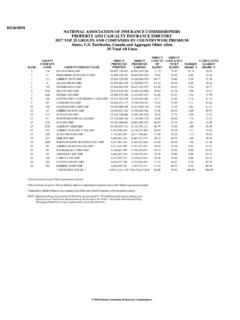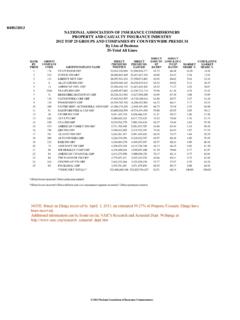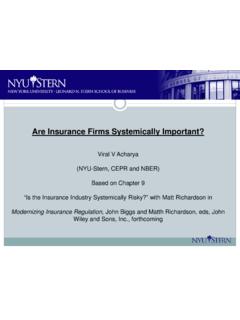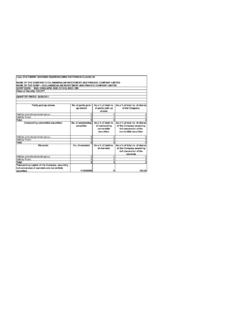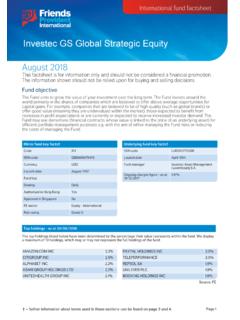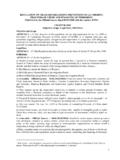Transcription of Bank Valuation Basics - Mercer Capital
1 bank Valuation Basics ! 2013 Mercer Capital // !1!1 bank Valuation Basics Jay D. Wilson, CFA, CBA February 19, 2013 Mercer Capital Depository Institutions Group 2 About Mercer Capital Overview Mercer Capital is a national business Valuation and financial advisory firm. Our clients include private and public operating companies , financial institutions, asset holding companies , high-net worth families, and private equity/hedge funds. Mercer Capital s technical discipline of providing well-grounded Valuation opinions is buttressed by real world experience gained in providing advisory services. Likewise, the market-centered orientation of financial advisory services has as its foundation a keen understanding of Valuation drivers.
2 Services Valuation Advisory & Opinions Corporate Transactions Financial Reporting Employee Benefit Plans Tax Compliance and Reporting Litigation Support Financial Advisory Corporate and Strategic Advisory Mergers & Acquisitions Fairness Opinions bank Valuation Basics ! 2013 Mercer Capital // !2!3 Outline for Today s Presentation Part One: Community Banks Part Two: Valuation Q&A Overview Financial Statement Basics Recent Industry Trends Overview Guideline Public Company Method Guideline Transactions Method Discounted Future Benefits Method Special Issues 4 Community Banks Overview Financial institutions include several kinds of financial entities Depository Institutions - Banks, bank holding companies , saving banks, mutual savings banks, stock-owned thrift institutions, mutual thrift institutions, and credit unions Asset managers RIAs, hedge fund managers, PE managers, broker/dealers, etc.
3 Insurance companies Agencies, Underwriters, Ancillary (Administrator/Claims Adjusters) Specialty Finance and Real Estate companies bank Valuation Basics ! 2013 Mercer Capital // !3!5 Community Banks Overview Depository institutions have several common characteristics Accept deposits from consumers and/or businesses Deposits are generally insured by the federal government Chartered by federal government or various states and regulated by agencies of these government Generally deploy the acquired deposits by making loans to customers, either businesses or consumers, or making other investments that provide earnings Community banks are a subset of this group 6 Community Banks Overview What is definition of a community bank ?
4 Lots of different definitions Historically, definition has been banks with less than $1 billion in assets FDIC definition is a bit more broad (FDIC Community Banking Study December 2012) Definition focuses on traditional lending and deposit gathering and limited geographic scope Based on FDIC definition, 7,658 FDIC insured community banks operating within 6,914 separate organizations Other interesting notes from FDIC study Multi-decade consolidation trend - 17,901 federally insured banks in 1984 to 7,357 in 2011 Share of industry assets held by community banks has declined. Banks with assets greater than $10 billion control 80% of industry assets in 2011 compared to 27% in 1984 bank Valuation Basics !
5 2013 Mercer Capital // !4!7 Community Banks Overview Banks vs. Operating companies Key Similarities The goal is to provide a return on Capital invested Key Differences A bank s success or failure has a more direct link to the balance sheet In operating companies , this link is less clear as issues such as marketing, technological innovation and market position can be more important than financial structure 8 Community Banks Financial Statement Basics Assets Liabilities and Stockholder s Equity Securities Portfolio Loan Portfolio Loan Loss Allowance Earning Assets Cash Plant, Property, and Equipment Intangible Assets Total Assets Demand Deposits Time & Savings Deposits Total Deposits Fed Funds Purchased Long-term Debt Total Liabilities Common Stock Stockholder s Equity Total Liabilities and Stockholder s Equity Balance Sheet Overview Assets consist primarily of cash and equivalents (vault cash, deposits at other banks, Fed Funds sold)
6 , investment securities, and loans Liabilities mostly consist of deposits Banks do not have distinction between current and long-term assets and liabilities Key difference from operating company Inherent leverage in business structure to support functioning of bank loans bank Valuation Basics ! 2013 Mercer Capital // !5!9 Community Banks Financial Statement Basics Total SecuritiesInterest IncomeTrading AccountLoansFed Funds + CDs + Rev ReposFed Funds Sold & CD'sGross Loans & LeasesSecuritiesLoan Loss AllowanceEstimated Tax Benefit Net Loans & LeasesInterest Income (FTE) Total Earning AssetsInterest ExpenseCash and Due From BanksDepositsBank PremisesFed Funds PurchasedOther Real Estate OwnedOther Interest ExpenseIntangible AssetsInterest ExpenseCash Surrender Value of Life InsuranceNet Interest Income (FTE)
7 Other AssetsTOTAL ASSETSFee IncomeDeposit Account Service ChargesOther Operating IncomeTotal Other IncomeNon-Interest Operating ExpenseSalaries & BenefitsNet OccupancyOther Operating ExpensesNon-Interest Operating ExpensesSecurity TransactionsLoan Loss ProvisionPre-Tax IncomeTaxes NET INCOMES ince a bank s balance sheet drives its income statement, let s start with the balance sheet 10 Community Banks Financial Statement Basics Key Balance Sheet Items Loan/Deposit or Loan/Asset Ratios one measure of the risk of a bank . A high loan/deposit ratio signals potentially higher liquidity risk. Low ratios signal less liquidity and credit risk, but at the expense of lowering profitability Loan Portfolio Composition extent of diversification among multiple types of loans Loan Loss Reserve - reserve to cover probable loan losses in the portfolio.
8 The loan loss reserve is reduced by loan losses and replenished by a charge to earnings Non-Performing Assets an asset that the bank has deemed to present greater-than-average risk of loss Capital the cushion available to absorb losses that occur or expand the bank s assets. Banking regulations provide benchmarks for Capital levels Capital adequacy is key bank Valuation Basics ! 2013 Mercer Capital // !6!11 Community Banks Financial Statement Basics Net Interest Income Interest Income-Interest Expense Most of banks revenues Must maintain spread between rates earned and rates paid (+) Non-Interest Income Complements interest income and helps offset expenses Important for growth and diversification (=)Total Revenues Total Revenues (-) Non-Interest Expenses Expenses not related to interest often occur during expansion and can be analyzed using the efficiency ratio (-) Loan Loss Provision Charge to replenish loan loss reserve (-) Income Taxes (=)
9 Net Income 12 Community Banks Financial Statement Basics Key Ratios Return on Equity Net Income/Equity Measures how productively the bank invests its Capital Return on Assets Net Income/Total Assets Measures the productivity of the assets deployed by the bank bank Valuation Basics ! 2013 Mercer Capital // !7!13 Community Banks Financial Statement Basics Risk Factors Credit Risk - potential that some of a bank s investments, in either loans or securities, may not be repaid according to their terms Interest Rate Risk - changes in net interest income or the change in the value of net assets caused by changes in market interest rates Liquidity Risk - bank s ability to meet its obligations, such as commitments to fund loans or deposit withdrawals, in the ordinary course of business Results from loans not being immediately marketable.
10 Such that a highly loaned-up bank may not be able to pay off maturing deposits 14 Community Banks Financial Statement Basics Banks are highly regulated entities Another key difference from most operating companies Key regulatory agencies include: Federal Deposit Insurance Corporation (FDIC) - guarantees safety of insured deposits with banks, through the Deposit Insurance Fund Office of the Comptroller of the Currency (OCC) - chief regulator officer for national banks and is responsible for governing the operations of national banks; assesses financial condition, soundness of operations, quality of management, and compliance with federal regulations Federal Reserve - central banking system of the ; also regulates bank holding companies Securities and Exchange Commission (SEC) - enforcing the federal securities laws and regulating the securities industry, the nation's stock and options exchanges, and other electronic securities markets bank Valuation Basics !

